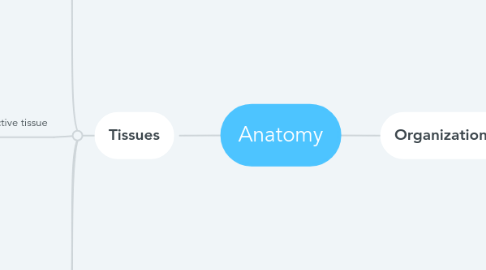
1. Tissues
1.1. Epithelial tissues
1.1.1. Sheets of tight cells that cover the body, they are protective barriers and surfaces for fluid or air exchange on the other side
1.1.2. Examples
1.1.2.1. Stratified squamous epithelium
1.1.2.1.1. Thin & leaky tissue suitable for exchanging materials by diffusion
1.1.2.2. Simple columnar epithelium
1.1.2.3. Simple cuboidal epithelium
1.1.2.4. Simple Squamous epithelium
1.1.2.5. Pseudostratified ciliated columnar epithelium
1.2. Connective tissue
1.2.1. Keep structures together and provide framework, protect against disease, repair tissue damage, etc.
1.2.2. Example
1.2.2.1. Loose connective tissue
1.2.2.1.1. Bind epithelia to underlying tissues and hold organs in place
1.2.2.2. Fibrous connective tissue
1.2.2.3. Adipose tissue
1.2.2.4. Cartilage
1.2.2.5. Bone
1.2.2.6. Blood
1.3. Muscle tissue
1.3.1. It consists of muscle fibers that can shorten or contract to make movement of the body
1.3.2. Example
1.3.2.1. Skeletal muscle
1.3.2.1.1. Attached to the tendons, they are responsible for voluntary movements such as walking
1.3.2.2. Cardiac muscle
1.3.2.3. Smooth muscle
1.4. Nervous tissue
1.4.1. Example
1.4.1.1. Neuron
1.4.1.1.1. The nerve cell specializes to conduct electrical nerve impulses
1.4.2. Located in the brain, spinal cord, and nerves, they sense stimuli and transmit information
2. Organization level
2.1. Organelle
2.1.1. Structures in a cell that perform different tasks
2.1.2. Ex) Golgi apparatus
2.2. Cell
2.2.1. The basic building blocks of all living things
2.2.2. Muscle cell
2.3. Tissue
2.3.1. Group of specialized cells that perform a function
2.3.2. Ex) Muscle tissue
2.4. Organ
2.4.1. Group of two or more tissues that together perform a specific task
2.4.2. Ex) Heart
2.5. Organ system
2.5.1. Multiple organs that work together for the body to function
2.5.2. Ex) Circulatory system
2.6. Organism
2.6.1. A set of organ systems each specialized to do a certain task functioning together as a unit
2.6.2. Ex) Human
